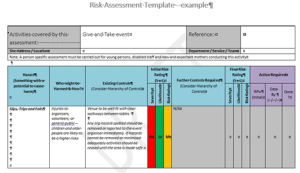Reuse Tips Give or Take Toolkit
Introduction
Households in England produced over 23 million tonnes of waste in 2021. A good proportion of this waste – 44% – was recycled; however, that still leaves a lot of waste to dispose of.
Give or Take events can help prevent items from going to waste, keeping them in use for longer which is better for the environment. The longer an item remains in use the lower its carbon, water, and waste footprint will be. It also reduces the need or demand to produce as many items from scratch, which protects our natural resources and uses less energy.
A Give or Take event can also provide an opportunity for us to rehome items that we no longer want or require and to find new items that we do want. It’s usually a great way to save money because we’re not buying things brand new.
So, we’ve produced a Give or Take toolkit to guide you through running your own Give or Take events. We’ve produced it based around a no money exchange and so items are donated for free and can be picked up and taken away for free. Getting rid of items you no longer want and knowing they’re going to be used by someone else can feel very rewarding and, of course, there’s nothing better than grabbing a bargain!
However, you could use a similar format for setting up a fundraising event for your community, either by charging an entrance fee, selling refreshments, or asking or a small amount per item.
Contents
Planning your Give or Take event
- Choosing a location/ venue
- Risk Assessment
- Choose a date and time
- Recruiting volunteers
- How to make it work
- Planning the event
- Health and Safety
- After the event
- Swapping systems
Promoting your event
On the day
Planning your Give or Take Event
Choosing a location/venue
Firstly, decide where you’re going to hold the event. This could be a table in the office to swap amongst colleagues, your front room with a group of friends, your local village hall, or community centre if you’re wanting to hold a bigger event.
For larger events, consider:
- Is the venue accessible for everyone?
- Is there adequate parking? Is there public transport to the venue?
- Are there appropriate facilities?
- Will the venue be appropriate for the number of visitors?
- Does the venue have public liability insurance?
Risk Assessment

It’s also important to consider any risks involved when organising events. Completing a Risk Assessment beforehand will help you think through the risks, and promote a positive, safe environment. It will help ensure that you comply with legal obligations and reduce the risks of an accident occurring, or a claim being made against you if something does go wrong.
We’ve included an example of a Risk Assessment below, which covers a variety of relevant points to consider before completing your own.
Risk Assessment example template in (Word) pdf.
Choose a date and time
When picking the perfect date for your event, it’s good to give sufficient notice to enable you to make all the arrangements, including booking the venue and publicising the event. This will also give people time to save the date and to sort out which items they would like to bring to the swap.
You might also want to consider setting up a drop off point for items to be left before the event starts – this could be a longer period of accepting donations in the run up to the event, or a couple of hours before.
Consider how long the event should last, sometimes a short ‘window of opportunity’ (a morning or afternoon) is better than all day.
Recruiting volunteers
If you’re opening your event up to the public, you’ll probably need a couple of people to lend a hand on the day, so having a few volunteers to help organise, promote, and manage the event can be very useful.
Volunteers can help:
- Spread the word by putting up posters around the community or publicising the event on social media
- Welcome people at the door on the day and assist those attending
- Sign items in and out, if you’d like to keep a record of what’s been given and taken
Top tips
- Make sure your venue is suitable – and you’ve got the right insurance if you need it
- Remember to complete a risk assessment in advance
- Give yourself plenty of time to plan and promote the event
- Consider if you need some extra help or support on the day
- Make a list of all the jobs required so you can see where you might need help
How to make it work
There are a variety of options for running your event, so you’ll need to decide which will work best for you.
Things to consider:
Planning the event
- Will you ask for an entrance fee to help recover any costs?
- Do you want people to bring their items on the day or can they be dropped off in advance?
- Do people need to bring an item with them to enable them to take an item, or can people attend and take something without bringing anything themselves?
- How are you going to display the items? Ideally, you want the layout to be immediately clear to attendees, such as in clear groups or categories. Would the event benefit from some signage?
- Will you be including clothing and if so, will there be somewhere for people to try the clothes on? Having mirrors available is a good idea. Alternatively, would you prefer to hold a separate swishing event for clothes? See Swishing Toolkit
- Will you be providing refreshments?
Health and Safety
- Do you want to include a size limit on items brought, to ensure that they’re manageable for people to take away? If so, you could set up an alternative method for larger items, perhaps suggesting that people bring a photo/picture to be displayed on a board?
- Heavy items could also pose an issue? Perhaps items over a certain weight could be labelled as such, and a trolley available to help with transporting items to cars?
- You might want to consider how you will manage any sharp or dangerous items donated, such a set of kitchen knives. Will you be able to ensure they are displayed where they can be supervised at all times and that anyone taking them is over 18?
- Will you be accepting electrical items as these will need PAT testing? Electricians can provide this service, along with some other organisations that deal with electrical item reuse (usually with a charge).
After the event
- What will you do with any items that remain? It’s good to decide this in advance and inform potential attendees
- How will you gauge if the event is successful? Could you ask attendees to provide feedback before they leave?
Swapping systems
We’ve listed a few popular systems below and it’s worth deciding in advance how you want your swap to work:
- Free-for-all
Attendees can take as many items as they like regardless of how many items they brought with them. - Ticket system
Tickets can be handed out depending on how many items are brought to the swap. Each ticket is then exchanged for a single item. This is a good way to limit the number of items that are taken by each attendee. - Points system
You may feel that a like-for-like swapping system based on item value is fairer than a free-for-all swap. Items can be assigned a ‘points’ value depending on their worth and attendees can only take items summing the total point value of what they brought. - Raising money for charity
Your event could be used as an opportunity to raise money for charity by allowing people to donate money in return for any items they take.
A clear swapping system can be important, especially for larger swaps, or those with an entry fee – although for small swaps with friends a free-for-all can be great fun!
Promoting your event
Spreading the word
If your event is open to the public, you might want to consider advertising to let people know that the event is taking place.
There are several ways you can publicise your event for little or no cost:
- Social media is a great low-cost way of advertising, as posts can be easily shared and reached by many people. Think about creating an event page on Facebook and invite friends and family, or for larger public swaps, share the event details in your local community Facebook groups.
- Putting up posters in public areas such as libraries, community centres and on village notice boards can be easy publicity and don’t underestimate the power of local word of mouth.
- If you want to reach a wider audience, consider getting in touch with community magazines and newspapers, and ask if they’ll feature the event.
Let people know what to bring
Ask people to bring clean items in good condition and include any other instructions, such as whether you want them to bring them on the day or in advance, if there is an entrance fee and what the system for swapping is. You will also need to give the timings for the day, location for the event and any parking instructions or travel guidance.
Provide clear guidance in your marketing so that people know what to expect when they arrive and what you expect from them. It’s also worth mentioning what you plan to do with any remaining items after the event.
On the day
At the event
Clear signage outside the venue will reassure people that they’re in the right place and guide them to the entrance. Ideally, it would be helpful to have someone at the entrance to welcome visitors and explain how the event works.
It will be easier for people to locate items if they are sorted, with similar items grouped together.
Swapping events should be fun, so try your best to create a friendly environment and positive atmosphere to encourage a spirit of goodwill.
Any items remaining at the end of the event can either be donated to a charity or kept for a future event.
Feedback
Consider gathering feedback from attendees on a flip chart, post-it-note or quick survey before they leave so that you know what their experience of the event was like.
Debrief
With any event, it’s a good idea to sit down afterwards with those involved for a debrief to discuss what worked well and what could be done differently as this can improve future events. You can also look through and evaluate any feedback from attendees.
Have you found our toolkit useful? Let us know your thoughts by emailing wasteprevention@leics.gov.uk
Also in Reuse Tips Sub menu











